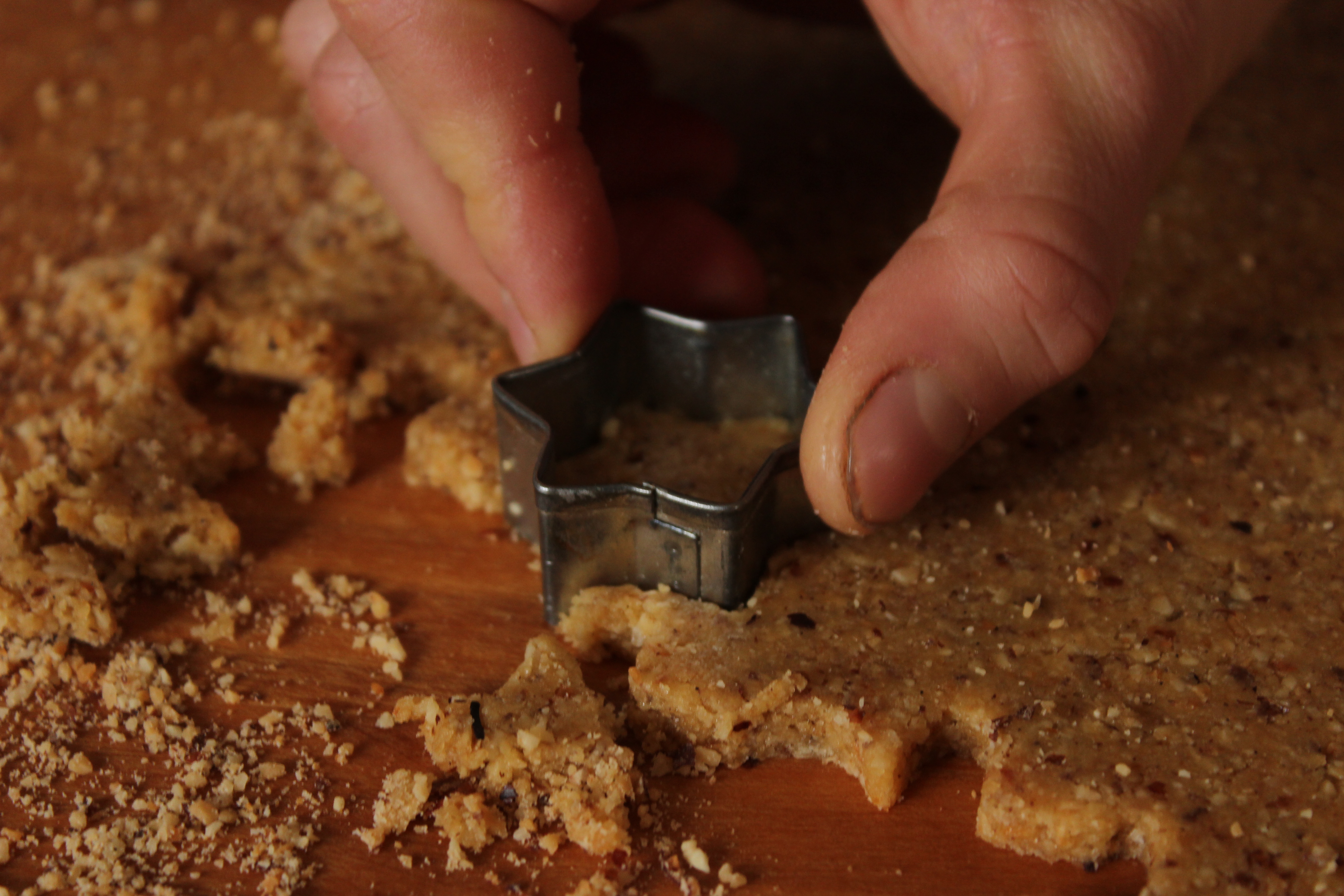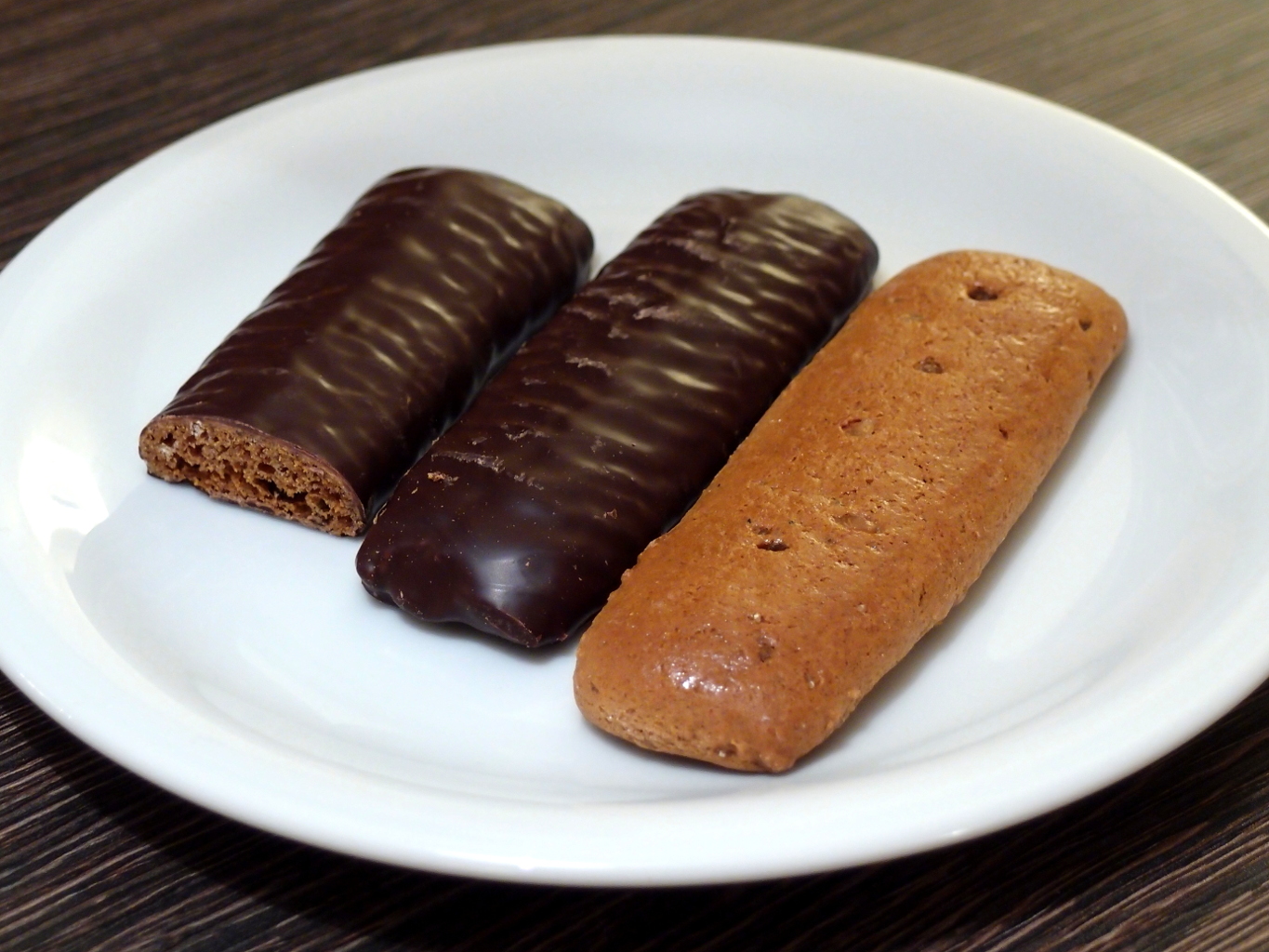|
Piñata Cookie
__NOTOC__ A piñata cookie is a sugar cookie that is shaped and colored like a piñata and filled with various small candies which spill out when the cookie is broken. Piñata cookies may be multicolored, which involves preparing separate batches of cookie dough and dyeing them different colors. The dough is then layered into a loaf with the various colors being separated A cookie cutter may be used to create various shapes. After the cookies are baked, they are further prepared by creating a hollow pocket, inside which the fillings are placed. They may be filled with candies, such as miniature M&Ms candy, chocolate buttons, or other ingredients. They are then sealed using frosting. Piñata cookies are sometimes prepared for Cinco de Mayo. Common ingredients in the dough's preparation include flour, vegetable oil, butter, sugar, powdered sugar, eggs, vanilla, salt, food coloring and baking soda. The piñata cookie was invented by Sandra Denneler in 2011, with the recipe going vi ... [...More Info...] [...Related Items...] OR: [Wikipedia] [Google] [Baidu] |
Sugar Cookie
A sugar cookie, or sugar biscuit, is a cookie with the main ingredients being sugar, flour, butter, eggs, vanilla, and either baking powder or baking soda. Sugar cookies may be formed by hand, dropped, or rolled and cut into shapes. They may be decorated with additional sugar, icing, sprinkles, or a combination of these. Decorative shapes and figures can be cut into the rolled-out dough using a cookie cutter. Name The name ''Nazareth cookie'' came from the people of Nazareth, Pennsylvania who came from Germany. The cookie later took on other names in other countries. In England they were called ''sugar biscuits'' as well as ''jumbles''. History Jumbles are the earliest form of sugar cookies. These cookies were very dry and were not very enjoyable; however people used them as Christmas ornaments. People would cut out these sugar cookies into different shapes and hang them on their Christmas tree. Published recipes for the sugar cookie began to appear in the 1800s. Some of t ... [...More Info...] [...Related Items...] OR: [Wikipedia] [Google] [Baidu] |
Piñata
A piñata (, ) is a container, often made of papier-mâché, pottery, or cloth, that is decorated, filled with candy, and then broken as part of a celebration. Piñatas are commonly associated with Mexico. The idea of breaking a container filled with treats came to Europe in the 14th century. The Spanish brought the European tradition to Mexico, although there were similar traditions in Mesoamerica, such as the Aztecs' honoring the birthday of the god Huītzilōpōchtli in mid-December. According to local records, the Mexican piñata tradition began in the town of Acolman, just north of Mexico City, where piñatas were introduced for catechism purposes as well as to co-opt the Huitzilopochtli ceremony. Today, the piñata is still part of Mexican culture, the cultures of other countries in Latin America, as well as the United States, but it has mostly lost its religious character. Etymology The Spanish language, Spanish word probably derives from the Italian language, Italian ... [...More Info...] [...Related Items...] OR: [Wikipedia] [Google] [Baidu] |
Cookie
A cookie is a sweet biscuit with high sugar and fat content. Cookie dough is softer than that used for other types of biscuit, and they are cooked longer at lower temperatures. The dough typically contains flour, sugar, egg, and some type of oil or fat. It may include other ingredients such as raisins, oats, chocolate chips, or nuts. Cookie texture varies from crisp and crunchy to soft and chewy, depending on the exact combination of ingredients and methods used to create them. People in the United States and Canada typically refer to all sweet biscuits as "cookies". People in most other English-speaking countries call crunchy cookies "biscuits" but may use the term "cookies" for chewier biscuits and for certain types, such as chocolate-chip cookies. Cookies are often served with beverages such as milk, coffee, or tea and sometimes dunked, which releases more flavour by dissolving the sugars, while also softening their texture. Factory-made cookies are sold in grocery ... [...More Info...] [...Related Items...] OR: [Wikipedia] [Google] [Baidu] |
Cookie Dough
Cookie dough is an uncooked blend of cookie ingredients. While cookie dough is normally intended to be baked into individual cookies before eating, edible cookie dough is made to be eaten as is, and usually is made without eggs to make it safer for human consumption. Cookie dough can be made at home or bought pre-made in packs (frozen logs, buckets, etc.). Dessert products containing cookie dough include ice cream and candy. In addition, pre-made cookie dough is sold in different flavors. When made at home, common ingredients include flour, butter, white sugar, salt, vanilla extract, and eggs. If the dough is made with the intention of baking, then leavening agent In cooking, a leavening agent () or raising agent, also called a leaven () or leavener, is any one of a number of substances used in doughs and batters that cause a foaming action (gas bubbles) that lightens and softens the mixture. An altern ...s such as baking soda or baking powder are added. However, these a ... [...More Info...] [...Related Items...] OR: [Wikipedia] [Google] [Baidu] |
Cookie Cutter
A cookie cutter in North American English, also known as a biscuit cutter outside North America, is a tool to cut out cookie/biscuit dough in a particular shape. They are often used for seasonal occasions when well-known decorative shapes are desired, or for large batches of cookies where simplicity and uniformity are required. Cookie cutters can also be used for shaping, molding, forming and cutting numerous other types of foods, including meat patties, flapjacks, sandwiches and decorative embellishments for platters (for example, fancy-cut fruit). Types and variations ;Cutout: Most commonly made of copper, tin, stainless steel, aluminium, or plastic. Cutouts are the simplest of the cookie cutters; the cutter is pressed into cookie dough that has been rolled flat to produce the shape of the cutter's outline. To keep the dough from sticking, they are often dipped in flour or sugar before use. ;Detail imprint: Commonly made of copper, tin, or plastic. Detail imprints ar ... [...More Info...] [...Related Items...] OR: [Wikipedia] [Google] [Baidu] |
Cinco De Mayo
Cinco de Mayo (; ) is an annual celebration held on May 5 to celebrate Mexico's victory over the Second French Empire at the Battle of Puebla in 1862, led by General Ignacio Zaragoza. Zaragoza died months after the battle from an illness, however, and a larger French force ultimately defeated the Mexican army at the Second Battle of Puebla and then occupied Mexico City. Following the end of the American Civil War in 1865, the United States began lending money and guns to the Mexican Liberals, pushing France and Mexican Conservatives to the edge of defeat. At the opening of the French chambers in January 1866, Napoleon III announced that he would withdraw French troops from Mexico. In reply to a French request for American neutrality, the American secretary of state William H. Seward replied that French withdrawal from Mexico should be unconditional. More popular in the United States than in Mexico, Cinco de Mayo has become associated with the celebration of Mexican-America ... [...More Info...] [...Related Items...] OR: [Wikipedia] [Google] [Baidu] |
Going Viral
Viral phenomena or viral sensations are objects or patterns that are able to replicate themselves or convert other objects into copies of themselves when these objects are exposed to them. Analogous to the way in which viruses propagate, the term ''viral'' pertains to a video, image, or written content spreading to numerous online users within a short time period. This concept has become a common way to describe how thoughts, information, and trends move into and through a human population. The popularity of viral media has been fueled by the rapid rise of social network sites, wherein audiences—who are metaphorically described as experiencing "infection" and "contamination"—play as passive carriers rather than an active role to 'spread' content, making such content "go viral". The term ''viral media'' differs from '' spreadable media'' as the latter refers to the ''potential'' of content to become viral. Memes are one known example of informational viral patterns. History ... [...More Info...] [...Related Items...] OR: [Wikipedia] [Google] [Baidu] |
Cookie Decorating
Cookie decorating dates back to at least the 14th century when in Switzerland, springerle cookie molds were carved from wood and used to impress Biblical designs into cookies. The artistic element of cookie making also can be traced back to Medieval Germany where Lebkuchen was crafted into fancy shapes and decorated with sugar. The story of "Hansel and Gretel " published with Grimm's Fairy Tales in 1812 inspired German gingerbread cookie Christmas cards. Also during the 17th century, Dutch people, Dutch and German settlers introduced cookie cutters, decorative molds, and festive holiday cookie decorations to the United States. Today cookie decorating traditions continue in many places in the world and include such activities as cookie decorating parties, competitions, creating cookie bouquets and cookie gift baskets, and simply decorating cookies with children as a fun family activity. Glaze, royal icing and Fondant icing, fondant are all popular choices for decorating cookies. ... [...More Info...] [...Related Items...] OR: [Wikipedia] [Google] [Baidu] |
List Of Cookies
This is a list of notable cookies (American English), also called biscuits (British English). Cookies are typically made with flour, egg, sugar, and some type of shortening such as butter or cooking oil, and baked into a small, flat shape. Cookies Unsorted * Almond biscuit * Cookie sandwich * Hadji bada * Stuffed cookie See also * List of baked goods * List of candies * List of crackers * List of desserts A dessert is typically the sweet Course (food), course that, after the entrée and main course, concludes a meal in the culture of many countries, particularly western world, Western culture. The course usually consists of sweet foods, but may ... * List of pastries * List of shortbread biscuits and cookies References {{DEFAULTSORT:Cookies * * Cookies Cookies ... [...More Info...] [...Related Items...] OR: [Wikipedia] [Google] [Baidu] |
National Public Radio
National Public Radio (NPR) is an American public broadcasting organization headquartered in Washington, D.C., with its NPR West headquarters in Culver City, California. It serves as a national Radio syndication, syndicator to a network of more than List of NPR stations, 1,000 public radio stations in the United States. Funding for NPR comes from dues and fees paid by member stations, Underwriting spot, underwriting from corporate sponsors, and annual grants from the publicly funded Corporation for Public Broadcasting. Most of its member stations are owned by non-profit organizations, including public school districts, colleges, and universities. NPR operates independently of any government or corporation, and has full control of its content. NPR produces and distributes both news and cultural programming. The organization's flagship shows are two drive time, drive-time news broadcasts: ''Morning Edition'' and the afternoon ''All Things Considered'', both carried by most NPR me ... [...More Info...] [...Related Items...] OR: [Wikipedia] [Google] [Baidu] |





